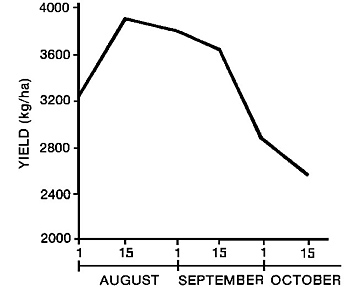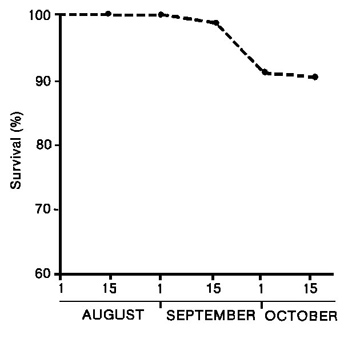| | Seedbed preparation | Seed selection | Time of seeding | Depth of seeding | Seeding rate
Seedbed Preparation
Like other cereal crops, fall rye will respond to a properly prepared seedbed. A good seedbed should be weed, disease and insect free. It should provide good seed/soil contact and be moist and warm.
Since most fall rye is often grown on light textured soils that are subject to wind erosion, pre-seeding tillage should be kept to a minimum. To aid in erosion control and to maximize snow trapping, use implements that will preserve the previous crop residue. Substituting herbicides for cultivation and seeding without pre-seeding tillage (minimum to zero till) are other practical considerations.
Highest yields of fall rye occur when it is planted on summerfallow; however, winterkill is more likely to occur. In areas subject to winterkill, seeding fall rye into the standing stubble of a spring-seeded crop is the best option. The stubble helps trap insulating snow, protecting young plants from severe winter weather.
Under dry or firm soil conditions, seed with implements that minimize soil disturbance, such as air drills with disc or narrow openers, to prevent soil drying, Growing rye repeatedly on the same land increases the chance of ergot infection. Rotation with less susceptible crops (flax, canola, barley, oats, wheat etc.) is recommended.
Perennial weeds, especially downy brome and quack grass, must be controlled prior to seeding fall rye. Winter annuals are best controlled with a fall herbicide application. Spring annual weeds, including wild oats, are rarely a problem because of rye’s strongly competitive nature and early regrowth start.
Seed Selection
Fall rye seed should be cleaned thoroughly to remove weed seeds, foreign material (including ergot) and cracked kernels. Ergot bodies must be removed to prevent re-infestation of fields. Using pedigreed seed ensures high quality. Some seed cleaning plants can remove the majority of ergot with optical sorters.
There are no ergot resistant rye varieties. The only practical control is to sow clean, year-old seed on land that hasn’t grown rye for at least a year. Mowing roadside and headland grass prior to seed set will reduce or eliminate this major source of ergot re-infestation.
Aside from open-pollinated varieties, new, hybrid fall rye varieties are also now available. The hybrid fall rye varieties provide a significant yield boost over conventional fall rye, with an increase in yield between 15 to 25 per cent, due to hybrid vigour. Hybrid seed does not breed true, and new seed will have to be purchased every year. The hybrid varieties tend to be semi-dwarf and less susceptible to lodging. Also, the hybrid fall ryes have higher falling numbers, making them more suitable for milling into flour.
Variety selection may be aided by consulting the annual publication Varieties of Cereal and Oilseed Crops for Alberta, Agdex 100/32 the Alberta Agriculture web site variety section or by consulting the Alberta Seed Guide, published every February.
Fall rye grain may be used as seed the same fall in which it is harvested, provided ergot is not a problem, as after-ripening requirements are satisfied through the swathing, drying and harvesting period. Research has shown that fall rye had an 87 per cent emergence when swathed at 40 to 45 per cent moisture, allowed to dry for 8 days and then planted. The curing time between swathing and planting rye usually exceeds this eight-day interval.
All fall rye varieties should be treated with a systemic seed treatment to protect the seed and seedling from rots and smuts. Rye tends to be more susceptible to stem smut, seed and seedling rots than other cereals.
There is no seed treatment for rye to protect against wireworm, so be aware of the problem when seeding rye on freshly broken land. Research across western Canada has shown a yield increase from seed treatment on average, and under some conditions, seed treatment has doubled the yield.
Time of Seeding
The optimum seeding dates for fall rye in southern and central Alberta are September 1 to 15. These dates regress to August 15 to September 1 if moving northward or to higher elevations. For fall pasture, the optimum seeding time is mid-August.
Seeding fall rye too early usually results in reduced grain yield and lower 1,000 kernel weight. Later seeding usually results in a yield reduction, delayed heading, later maturity, reduced plant height and lower bushel weight. Seeding too late can result in poorer winter survival.

Figure 1. Influence of seeding date on yield of rye produced on summer fallow (mean of five trials).
Source: Crop Development Center, University of Saskatchewan, Saskatoon.

Figure 2. Influence of seeding date on per cent winter survival of rye grown in north-central Saskatchewan. Source: Crop Development Center, University of Saskatchewan, Saskatoon.
Generally, it is necessary for the crop to grow 4 to 6 weeks before the onset of vernalization and cold hardening conditions (daytime temperatures below +10°C and decreasing day length). The top growth should be 3 to 4 inches high.
Do not delay planting because of grasshoppers. Grasshoppers feed mainly on the field margins. Delaying seeding may result in a better crop in these areas, but it may jeopardize the whole crop in an extremely cold winter when maximum cold hardening is needed. What is gained through reduced grasshopper damage is usually lost in reduced yields caused by less cold tolerance.
Rye will germinate at lower moisture levels than most cereals. Occasionally, surface moisture conditions may be unsuitable for germination around the recommended seeding date. Under such conditions, the problem is one of deciding whether or not to delay seeding. No definite answer can be offered to this problem, but most areas of the prairies do receive sufficient moisture during the month of September to germinate rye. It can’t germinate unless it’s in the ground ready to utilize the September rain.
In studies at Saskatoon, May and June seedings were almost invariably completely winterkilled; July seedings were severely damaged.Seedings made in late August or early September came through the best and when the mid-afternoon soil temperature at seeding depth had cooled to about 18°C.
However, fall rye is commonly seeded in the spring for use as annual pasture in the summer and fall. For grazing purposes, spring-seeded fall rye will winterkill and provide little grain or grazing the follow spring.
Depth of Seeding
Seed fall rye shallow, preferably 1 to 1.5 inches into a firm, moist seedbed. Research has shown that fall rye sown at a 1 inch depth had twice the emergence of that sown at 2 inches and that shallow-seeded fall rye had greater winter hardiness. Shallow seeding also allows for rapid emergence from the soil.
When shallow seeding, the previous crop’s residue will have a greater tendency to interfere with good seed-to-soil contact. Even spreading of the previous crop residue is essential for quick emergence. Make sure seed-to-soil contact occurs. Packer wheels greatly enhance the establishment and winter hardening of the crop.
When seeding into untilled stubble fields, adequate drill penetration and furrow fill are often problems because of the dry, packed fall soil conditions. Hoe drills and minimum tillage drills provide the most positive penetration in this type of seedbed and give the best assurance of good seed-to-soil contact through furrow closure with packed soil. Soil moisture in stubble fields rarely improves with depth, so there is little to be gained by seeding deeper than the minimum required to give good coverage of the seed with packed soil.
When seeding on summerfallow, take extra care to obtain a firm seedbed to facilitate shallow seed placement into moist soil and to prevent soil erosion by wind.
Seeding Rate
Fall rye intended as a grain crop should be sown at 55 to 60 lb/acre (1 bu/acre). Fall rye planted for late fall or early spring pasture may be sown at a heavier rate of 55 to 110 lb/acre (1.5 - 2 bu/acre).
The higher seeding rates are used for varieties with a larger kernel size and lower rates for smaller seeded varieties. Although current varieties have similar book value 1,000 kernel weights, there can be big differences with 1,000 kernel weights from year to year, depending on growing conditions. Use the Cereal Seed Calculator on the Alberta Agriculture website to get desired plant populations (http://agriculture.alberta.ca/app19/loadSeedRateCalc).
The seeding rate varies not only with the seed size (grams per 1,000 kernels) but with the germination percentage of the seed and general seedbed conditions. A target of 20 to 24 live healthy plants per square foot is adequate for maximum grain yield.
The following example shows how to calculate seeding rate in pounds per acre of fall rye with a 93 per cent germination rate, 33 grams per 1,000 kernel weight and a seedbed emergence mortality rate of 3 per cent. Target plant population is 20 plants per square foot.
| Adjusting for germination (93%) and 3% |
| mortality = | 20 plants | x | ___1___ | = 22 kernels |
 | sq ft |  | (.93 - .03) |  |
need to be sown per square foot to get 20 live plants
Then:
22 kernels | x ____33g____ | x 1 lb* | x 43560 sq ft | = 70 lb/ac |
1 sq ft | 1,000 kernels | 454g | ac |  |
* l pound equals 454 grams
70 lb/ac is the seeding rate needed. The Alberta Agriculture web site calculator will do this for you.
More Information
For additional information see the publication Fall Rye Production, Agdex 117/20-1.
Acknowledgements
The author wishes to express a sincere thank you to Walter Yarish, Tim Ferguson, Ieuan Evans, Mike Dolinski, Doug Penney, J. Thomas, Don Salmon, Bob Nelson, Grant McLeod, Keith Briggs, Dave McAndrew, Myron Bjorge, Bob Wroe, Russel Horvey, Alan Toly, Bob Wolfe, Blair Shaw, Bill Chapman, Wayne Jackson, Larry Welsh, Ellis Treffry, Gordon Hutton, Allan Macaulay, Mike Rudakewich and Lu Piening for their constructive criticism in reviewing and improving this manual.
A special thanks to Arvid Aasen who wrote, with the help of Ken Lopetinsky, Vern Baron, Ellis Treffry and Myron Bjorge, the pasture, the hay and silage section.
Prepared by:
Murray McLelland formerly with Alberta Agriculture and Rural Development
Revised by:
Harry Brook, Alberta Agriculture and Forestry
Source: Agdex 117/20-1. Revised June 2018. |
|